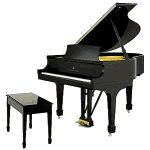

Choose the letter which begins musical term that you would like to learn about:
| A | B | C | D | E | F | G | H | I | J | K | L | M | N | O | P | Q | R | S | T | U | V | W | X | Y | Z |
TantoMuch, so much.
TempoThe rate of speed in a musical work.
Tempo primoReturn to the original tempo.
TeneramenteTenderly.
Tenor clefThe C clef falling on the fourth line of the staff.
Tenuto, tenHold or sustain a note longer than the indicated value, usually not as long a duration as the fermata.
Ternary formThree-part form in which the middle section is different from the other sections. Indicated by ABA.
Terraced dynamicsThe Baroque style of using sudden changes in dynamic levels, as opposed to gradual increase and decrease in volume.
Tertian harmonyA term used to describe music based on chords arranged in intervals of thirds.
TessituraThe general pitch range of a vocal part.
TextureThe term used to describe the way in which melodic lines are combined, either with or without accompaniment. Types include monophonic, homophonic, and polyphonic, or contrapuntal.
ThemeThe musical subject of a piece (usually a melody), as in sonata form or a fugue. An extramusical concept behind a piece.
Theme and variationsA statement of musical subject followed by restatements in different guises.
TheoryThe study of how music is put together.
ThirdThe third degree of the diatonic scale. Also, the interval formed by a given tone and the third tone above or below it, e.g. c up to e, or c down to a. Intervals of the third may be major, minor, diminished, or augmented.
Through-composedA term used to describe a song in which the music for each stanza is different. The opposite of strophic.
TiIn solmization, the seventh degree of the major scale. Also called the leading tone.
TieA curved line over or below two or more notes of the same pitch. The first pitch is sung or played and held for the duration of the notes affected by the tie.
Time signatureSynonymous with meter signature.
TonalityThe term used to describe the organization of the melodic and harmonic elements to give a feeling of a key center or a tonic pitch.Tone
A note; the basis of music.
Tone clustersThe simultaneous sounding of two or more adjacent tonic tones.
TonguingOn wind instruments, articulation with the tongue.
TonicThe first note of a key. Also, the name of the chord built on the first degree of the scale, indicated by I in a major key or i in a minor key.
TonoTone, key, pitch.
TostoQuick.
TranquilloTranquilly; quietly; calm.
TranspositionThe process of changing the key of a composition.
TreThree. Used with other terms, e.g. a tre voci, in three parts.
Treble clefThe G clef falling on the second line of the staff.
TriadA chord of three tones arranged in thirds, e.g. the C-major triad c-e-g, root-third-fifth.
Trill, trA musical ornament performed by the rapid alternation of a given note with a major or minor second above.
Triple meterMeter based on three beats, or a multiple of three, in a measure.
TripletA group of three notes performed in the time of two of the same kind.
TroppoToo much. Used with other terms, e.g. allegro non troppo, not too fast.
TurnA musical ornament characterized by the rapid performance of a given note, the major or minor second above and below, and a return to the given note.
TuttiAll. A direction for the entire ensemble to sing or play simultaneously.
Twelve-tone techniqueA system of composition which uses the twelve tones of the chromatic scale in an arbitrary arrangement called a tone row or series. The row may be used in its original form, its inversion, in retrograde, and in the inversion of the retrograde. The system was devised by Arnold Schoenberg in the early Twentieth century.

A B C D E F G H I J K L M N O P Q R S T U V W X Y Z
Some definitions and terms excerpted from
Belwin Pocket Dictionary of Music: Music Theory Dictionary
By Dr. William Lee
Students may purchase a copy for home use at cost
Many thanks to Dearest for everything!
is located
in Fairfax, Virginia
Over 30 Years
~~
Piano, Organ
Electric Keyboard
Accompanying
All rights reserved.
Site design and maintenance by
O'Connor O'Riginals Web Design
